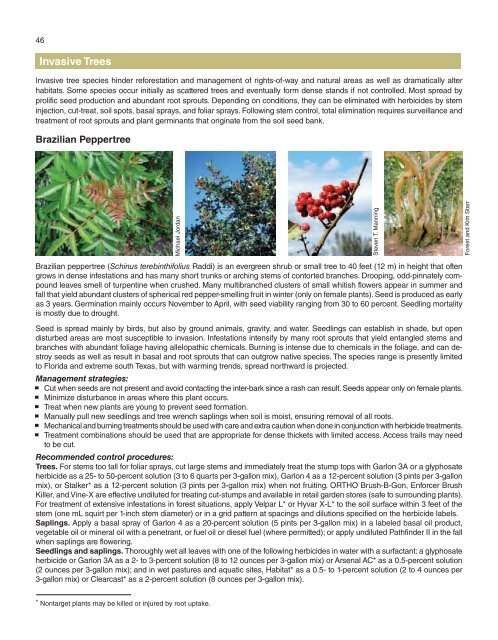A Management Guide for Invasive Plants in Southern Forests James ...
A Management Guide for Invasive Plants in Southern Forests James ...
A Management Guide for Invasive Plants in Southern Forests James ...
- No tags were found...
Create successful ePaper yourself
Turn your PDF publications into a flip-book with our unique Google optimized e-Paper software.
46<strong>Invasive</strong> Trees<strong>Invasive</strong> tree species h<strong>in</strong>der re<strong>for</strong>estation and management of rights-of-way and natural areas as well as dramatically alterhabitats. Some species occur <strong>in</strong>itially as scattered trees and eventually <strong>for</strong>m dense stands if not controlled. Most spread byprolific seed production and abundant root sprouts. Depend<strong>in</strong>g on conditions, they can be elim<strong>in</strong>ated with herbicides by stem<strong>in</strong>jection, cut-treat, soil spots, basal sprays, and foliar sprays. Follow<strong>in</strong>g stem control, total elim<strong>in</strong>ation requires surveillance andtreatment of root sprouts and plant germ<strong>in</strong>ants that orig<strong>in</strong>ate from the soil seed bank.Brazilian PeppertreeMichael JordanSteven T. Mann<strong>in</strong>gForest and Kim StarrBrazilian peppertree (Sch<strong>in</strong>us tereb<strong>in</strong>thifolius Raddi) is an evergreen shrub or small tree to 40 feet (12 m) <strong>in</strong> height that oftengrows <strong>in</strong> dense <strong>in</strong>festations and has many short trunks or arch<strong>in</strong>g stems of contorted branches. Droop<strong>in</strong>g, odd-p<strong>in</strong>nately compoundleaves smell of turpent<strong>in</strong>e when crushed. Many multibranched clusters of small whitish flowers appear <strong>in</strong> summer andfall that yield abundant clusters of spherical red pepper-smell<strong>in</strong>g fruit <strong>in</strong> w<strong>in</strong>ter (only on female plants). Seed is produced as earlyas 3 years. Germ<strong>in</strong>ation ma<strong>in</strong>ly occurs November to April, with seed viability rang<strong>in</strong>g from 30 to 60 percent. Seedl<strong>in</strong>g mortalityis mostly due to drought.Seed is spread ma<strong>in</strong>ly by birds, but also by ground animals, gravity, and water. Seedl<strong>in</strong>gs can establish <strong>in</strong> shade, but opendisturbed areas are most susceptible to <strong>in</strong>vasion. Infestations <strong>in</strong>tensify by many root sprouts that yield entangled stems andbranches with abundant foliage hav<strong>in</strong>g allelopathic chemicals. Burn<strong>in</strong>g is <strong>in</strong>tense due to chemicals <strong>in</strong> the foliage, and can destroyseeds as well as result <strong>in</strong> basal and root sprouts that can outgrow native species. The species range is presently limitedto Florida and extreme south Texas, but with warm<strong>in</strong>g trends, spread northward is projected.<strong>Management</strong> strategies:Cut when seeds are not present and avoid contact<strong>in</strong>g the <strong>in</strong>ter-bark s<strong>in</strong>ce a rash can result. Seeds appear only on female plants.M<strong>in</strong>imize disturbance <strong>in</strong> areas where this plant occurs.Treat when new plants are young to prevent seed <strong>for</strong>mation.Manually pull new seedl<strong>in</strong>gs and tree wrench sapl<strong>in</strong>gs when soil is moist, ensur<strong>in</strong>g removal of all roots.Mechanical and burn<strong>in</strong>g treatments should be used with care and extra caution when done <strong>in</strong> conjunction with herbicide treatments.Treatment comb<strong>in</strong>ations should be used that are appropriate <strong>for</strong> dense thickets with limited access. Access trails may needto be cut.Recommended control procedures:Trees. For stems too tall <strong>for</strong> foliar sprays, cut large stems and immediately treat the stump tops with Garlon 3A or a glyphosateherbicide as a 25- to 50-percent solution (3 to 6 quarts per 3-gallon mix), Garlon 4 as a 12-percent solution (3 p<strong>in</strong>ts per 3-gallonmix), or Stalker* as a 12-percent solution (3 p<strong>in</strong>ts per 3-gallon mix) when not fruit<strong>in</strong>g. ORTHO Brush-B-Gon, En<strong>for</strong>cer BrushKiller, and V<strong>in</strong>e-X are effective undiluted <strong>for</strong> treat<strong>in</strong>g cut-stumps and available <strong>in</strong> retail garden stores (safe to surround<strong>in</strong>g plants).For treatment of extensive <strong>in</strong>festations <strong>in</strong> <strong>for</strong>est situations, apply Velpar L* or Hyvar X-L* to the soil surface with<strong>in</strong> 3 feet of thestem (one mL squirt per 1-<strong>in</strong>ch stem diameter) or <strong>in</strong> a grid pattern at spac<strong>in</strong>gs and dilutions specified on the herbicide labels.Sapl<strong>in</strong>gs. Apply a basal spray of Garlon 4 as a 20-percent solution (5 p<strong>in</strong>ts per 3-gallon mix) <strong>in</strong> a labeled basal oil product,vegetable oil or m<strong>in</strong>eral oil with a penetrant, or fuel oil or diesel fuel (where permitted); or apply undiluted Pathf<strong>in</strong>der II <strong>in</strong> the fallwhen sapl<strong>in</strong>gs are flower<strong>in</strong>g.Seedl<strong>in</strong>gs and sapl<strong>in</strong>gs. Thoroughly wet all leaves with one of the follow<strong>in</strong>g herbicides <strong>in</strong> water with a surfactant: a glyphosateherbicide or Garlon 3A as a 2- to 3-percent solution (8 to 12 ounces per 3-gallon mix) or Arsenal AC* as a 0.5-percent solution(2 ounces per 3-gallon mix); and <strong>in</strong> wet pastures and aquatic sites, Habitat* as a 0.5- to 1-percent solution (2 to 4 ounces per3-gallon mix) or Clearcast* as a 2-percent solution (8 ounces per 3-gallon mix).* Nontarget plants may be killed or <strong>in</strong>jured by root uptake.
















